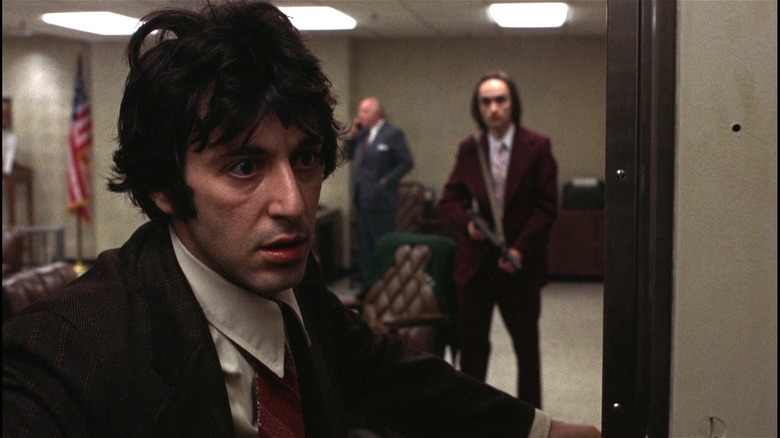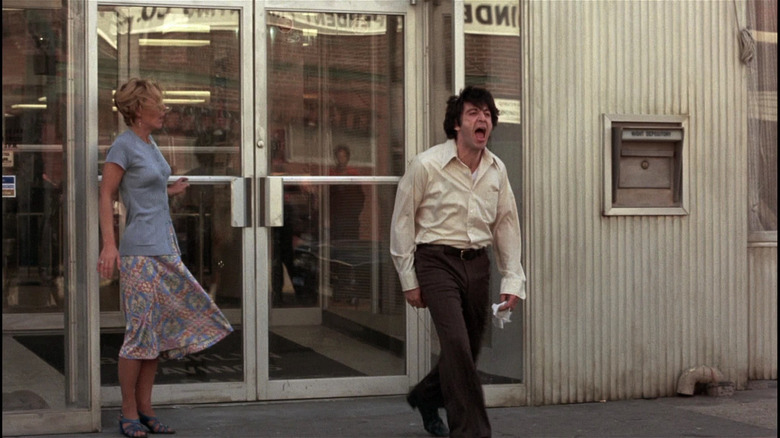The Script For Dog Day Afternoon Was Packed With Al Pacino Improv
"Dog Day Afternoon" is one of the greatest achievements of naturalistic 1970s filmmaking. Taking place over the course of one sweltering summer day, the film is based on the true story of Sonny Wortzik, whose attempt to rob a Brooklyn bank devolves into a media circus, hostage situation, and law enforcement standoff. Al Pacino's tour de force performance anchors the film with a razor-sharp tension and wit, alongside an equally intense supporting cast of John Cazale, Chris Sarandon, Charles Durning, and more. The entire cast has an electric connection and propulsive energy that brings gritty New York characters to life.
What makes the actors' performances so dynamic is the use of improvisation. On the DVD commentary, Sidney Lumet describes the relationship between Frank Pierson's snappy screenplay and the actors' ad libs:
"It was a script I accepted, that Al accepted, that we were all thrilled to be working on. And in general, I don't like actors to improvise, to use their own language. They are not going to come up with something that's going to be better than a really talented writer who's done months of work on something."
But Lumet became more open to improvisation because he was already shooting the film in a documentary-esque style. He saw it would help his actors find characters' language and emotion, especially because the film is a taut narrative that relies on nimble reactions. Lumet elaborated in Hollywood Interview:
"I told the actors 'Look, as long as you don't change the meaning of anything, or shift the scene to another direction, use your own words. ' And by the way I did this with the complete approval of the writer, Frank Pierson, who was there and wrote a wonderful screenplay. And we never changed the structure of anything ... much of what we used were Frank's words."
Improvisations were mostly done during rehearsals and transcribed by secretaries so Pierson and Lumet could have them. A good fraction of the dialogue in "Dog Day Afternoon" was molded by the actors in rehearsal, but a few major scenes were improvised as the cameras rolled.
Scenes were improvised during filming
One of the most significant scenes that was improvised during shooting was with Sonny and Sergeant Moretti (Charles Durning). After Sal (John Cazale) fires his gun because they believe the cops are sneaking in through the back of the bank, Moretti must work hard to defuse Sonny, a ticking time bomb of nervous energy. He placates Sonny by promising to fulfill his requests for a helicopter, a phone call with his wife, and pizzas. The gripping sequence plays like a Ping-Pong match as the characters negotiate while refusing to budge from their position.
There's a minor but humorous instance of improvisation when Sonny asks Sal if there is any particular country he wants to visit. In the script, Sal was not supposed to answer, but Cazale quipped, "Wyoming." Al Pacino replied in character, "Sal, Wyoming's not a country" (via Roger Ebert).
"Dog Day Afternoon" is filled with tiny comedic details like this, such as when Pacino tries to balance his gun and a giant plant falls in his face. These little happenstances magnify the bank robbers' ineptitude and innocence, and they affirm that their mission was doomed from the start.
Pacino claims in Lawrence Grobel's biography of the actor that the pivotal phone call scene with Sonny's wife, Leon, was improvised, a trans woman Sonny is robbing the bank for in order to fund her gender-affirming surgery. Sidney Lumet holds tight on both their anguished faces as they discuss Sonny's foolish plan and Leon's hospital stay. The director notoriously filmed the scene in real time and used repeated takes to push Pacino to the point of exhaustion, as you can see in the beads of sweat pooling on Pacino's forehead and saucer-wide eyes (via The Sheila Variations). All these spontaneous moments create a film that feels very genuine and lively, and they make it one of the most enduring classics in cinema history.

